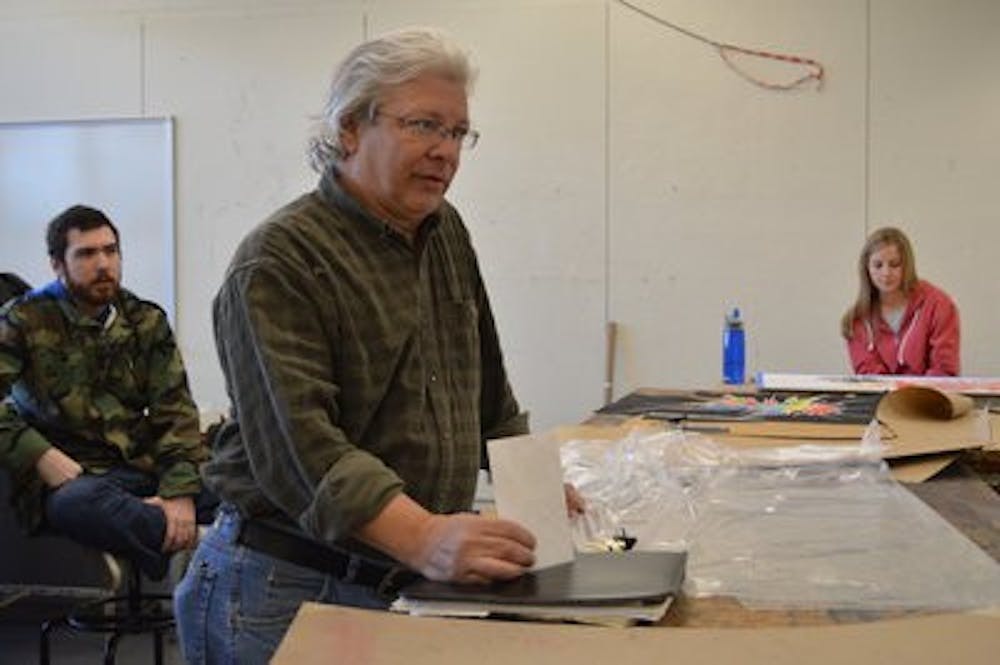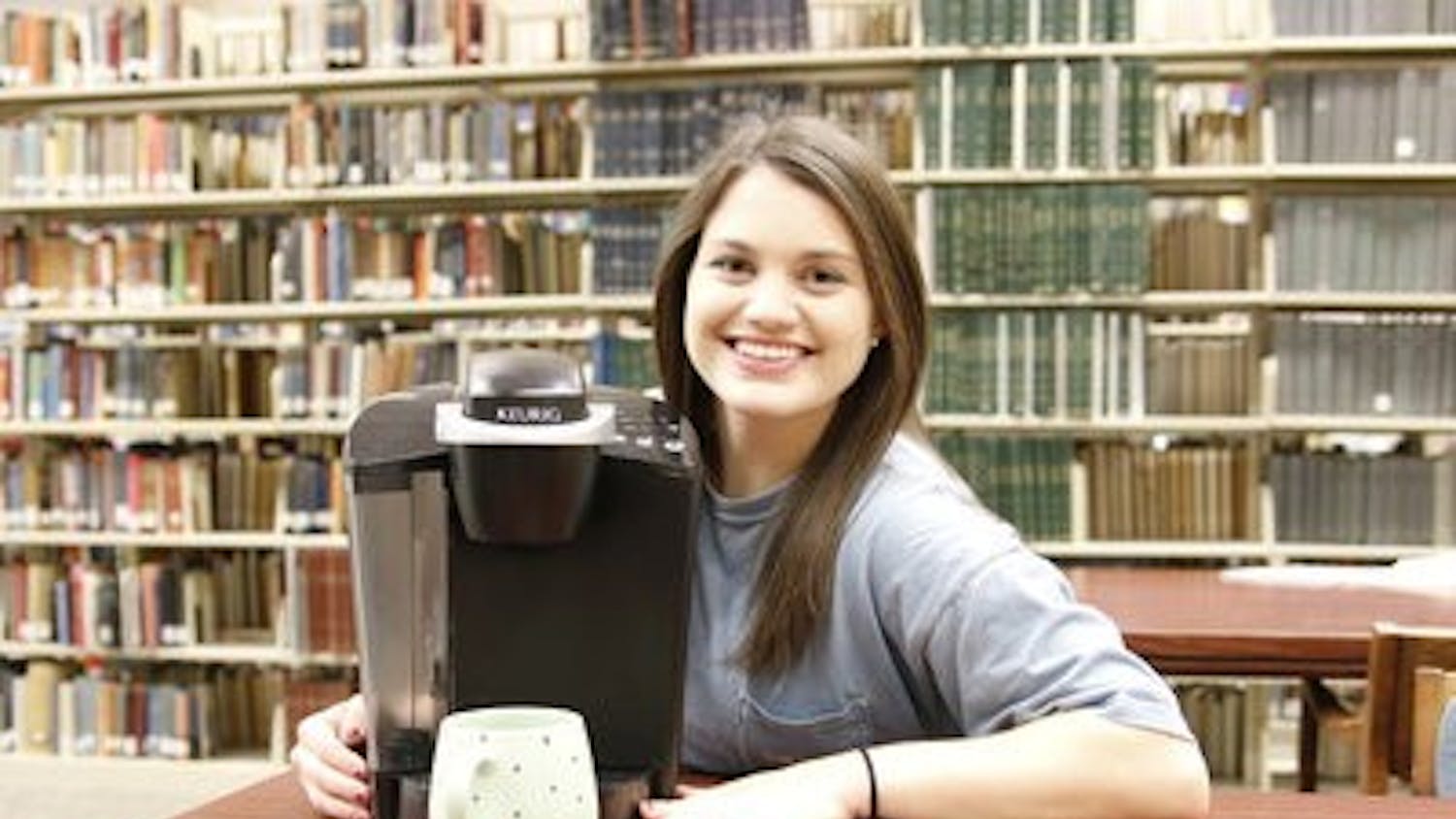One day, Barry Fleming, associate professor of art, was doing raku, a Korean technique in firing ceramics, and nothing was going to stop him.
In the middle of working, Fleming accidentally pushed through the thin window in the studio and cut his wrist.
The cut was so deep he would need a dozen stitches, but even so, he pressed on.
The artist took several brown paper towels and made a makeshift cast with masking tape, and did firings for several hours before stopping at the emergency room on his way home.
"I knew I needed to be sewn up, but the pottery was hot in the kiln," Fleming said. "I was going to need to get those 15 stitches anyway, but to interrupt my raku when I was having such a good time? I didn't see the need."
After teaching for 27 years, Fleming holds a similar attitude in the classroom.
"I enjoy creating somewhat of an uncomfortable atmosphere in my classes, and keeping students on their toes," Fleming said. "Keeping people a bit uncomfortable is ideal because comfort is the enemy of art."
While he's changed his teaching style since the 80s, Fleming said he enjoys remembering how he used to keep his students uncomfortable.
Once, Fleming assigned his students to create a drawing to depict an intense image without being cliche.
"This one student drew a lighter by itself, which is the exact opposite of what I asked," Fleming said. "So I had a lighter in my pocket and took advantage of it."
Fleming ignited the bottom of the drawing, unpinned it from the wall and stamped it out -- the ashes creating tone and shape variation.
"I hung it back on the wall and said, 'Now that's intense,'" Fleming said. "I wanted to improve it, so I did."
Fleming said he enjoys incorporating what he calls a Zen shock moment into his lessons, such as the experience with the lighter.
"There are certain times to explore the possibilities of what the student might choose for expressive means," Fleming said. "All I want is to help them see things a different way, and shed light on order that doesn't have to be there."
Carol Hartsell, former senior comedy editor at the Huffington Post, is a former student of Fleming's.
Hartsell said she was greatly inspired by Fleming's attitude toward art.
"He quickly became one of my favorite professors because he let art be important without being precious," Hartsell said. "To this day, he is the most unpretentious serious artist I've ever met."
Hartsell said one of the greatest ways Fleming influenced her as a person was the way he dealt with losing a finger.Back in the mid-90s when Hartsell was a student, Fleming almost sliced his finger off during at a shop accident.
"He later told me he had a choice and that he could have had his finger reattached, but he wouldn't be able to move it," Hartsell said. "His attitude was, 'Well, if I can't move it, it'll just be in the way, so take it off.' That blew my mind. I want to be that unfazed by troubles and stay focused on what I have to do."
Fleming said he's enjoyed teaching because he's learned as much as his students.
"I love giving students a different perspective from what they already have," Fleming said. "I've learned tremendous amounts from students in return including how to communicate the most effectively and create the most excitement."
Jessica Sabo, another former student of Fleming's, had similar experiences with him.
"He openly appreciates equally the sacred and the bizarre," Sabo said. "He taught me to find inspiration and wisdom in the places I might least expect to find them -- both within myself and in the world."
Five years after graduation, Sabo said she's still telling heartwarming stories about her former professor.
"Fleming's the kind of person that sticks with you like cat head biscuits and gravy," Sabo said. "His authenticity as a person and heart as an artist continue to impact and inspire me in my own life journey."
Fleming has developed his talent as an artist over several decades and said he realized his passion for art when he was a freshman at Western Kentucky University.
"My first art professor, Fae Hardy, asked us, 'Why do you [want to] be an artist?'" Fleming said with a smile. "After a series of wrong answers from 'to become famous,' or 'make money,' she said, 'You make art because you have to make art!'"
In that moment, Fleming said a transformation took place inside of him.
"A part of me acknowledged that I didn't have to make art, but then a voice inside said, 'No, I think you do,'" Fleming said. "I surely had to, and I want to pass that 'had to' on to as many students as I can."
Hartsell said more than anything, Fleming showed her how to have a critical eye and remain true to herself at the same time.
"As an artist, you get so caught up in proving yourself that you forget who you are, but Barry makes you remember," Hartsell said. "Frankly, if I had college to do over again, I'd spend as much time hanging out with professor Fleming as I could because it would make me a better and more informed person overall."
Do you like this story? The Plainsman doesn't accept money from tuition or student fees, and we don't charge a subscription fee. But you can donate to support The Plainsman.




